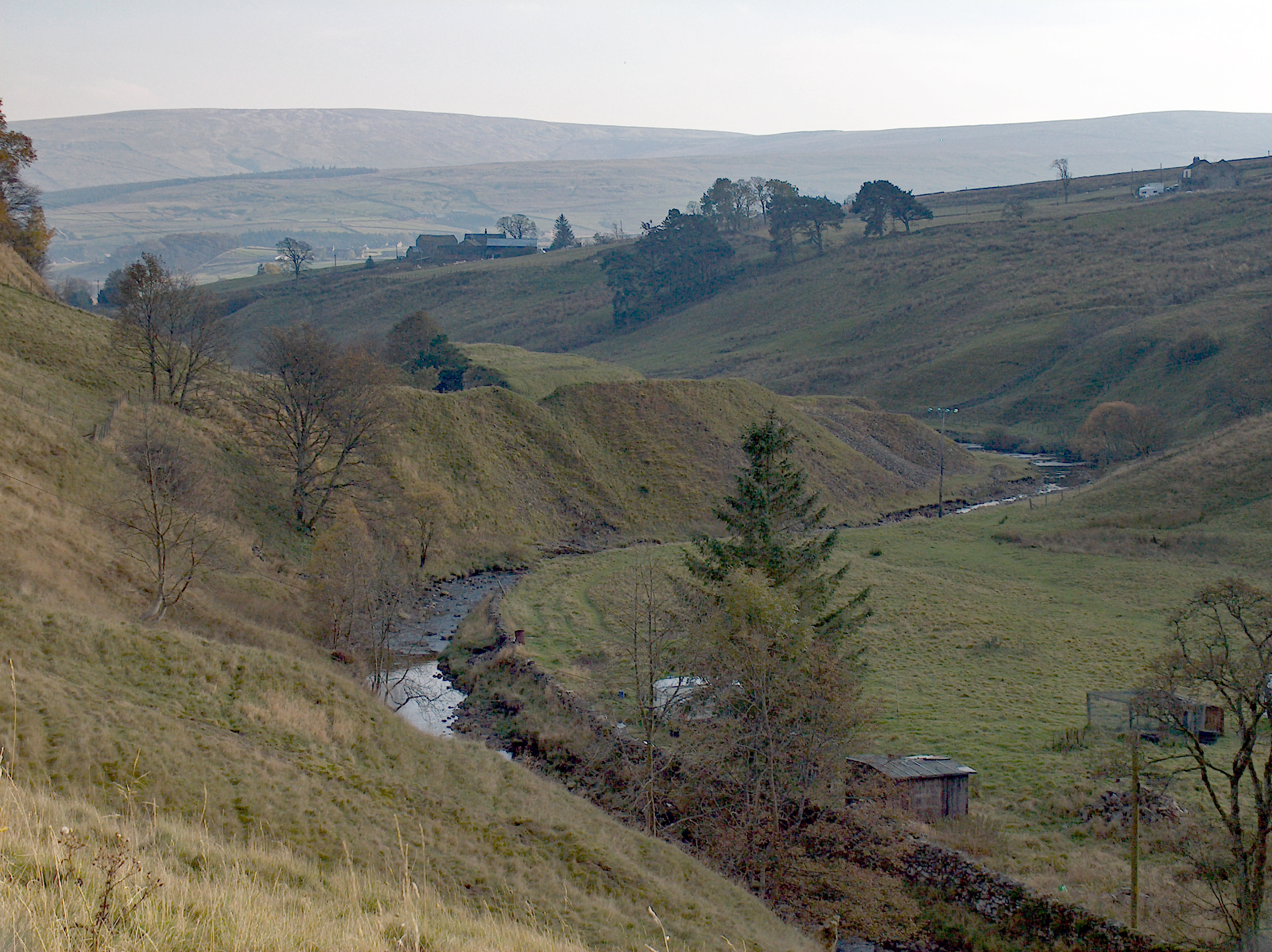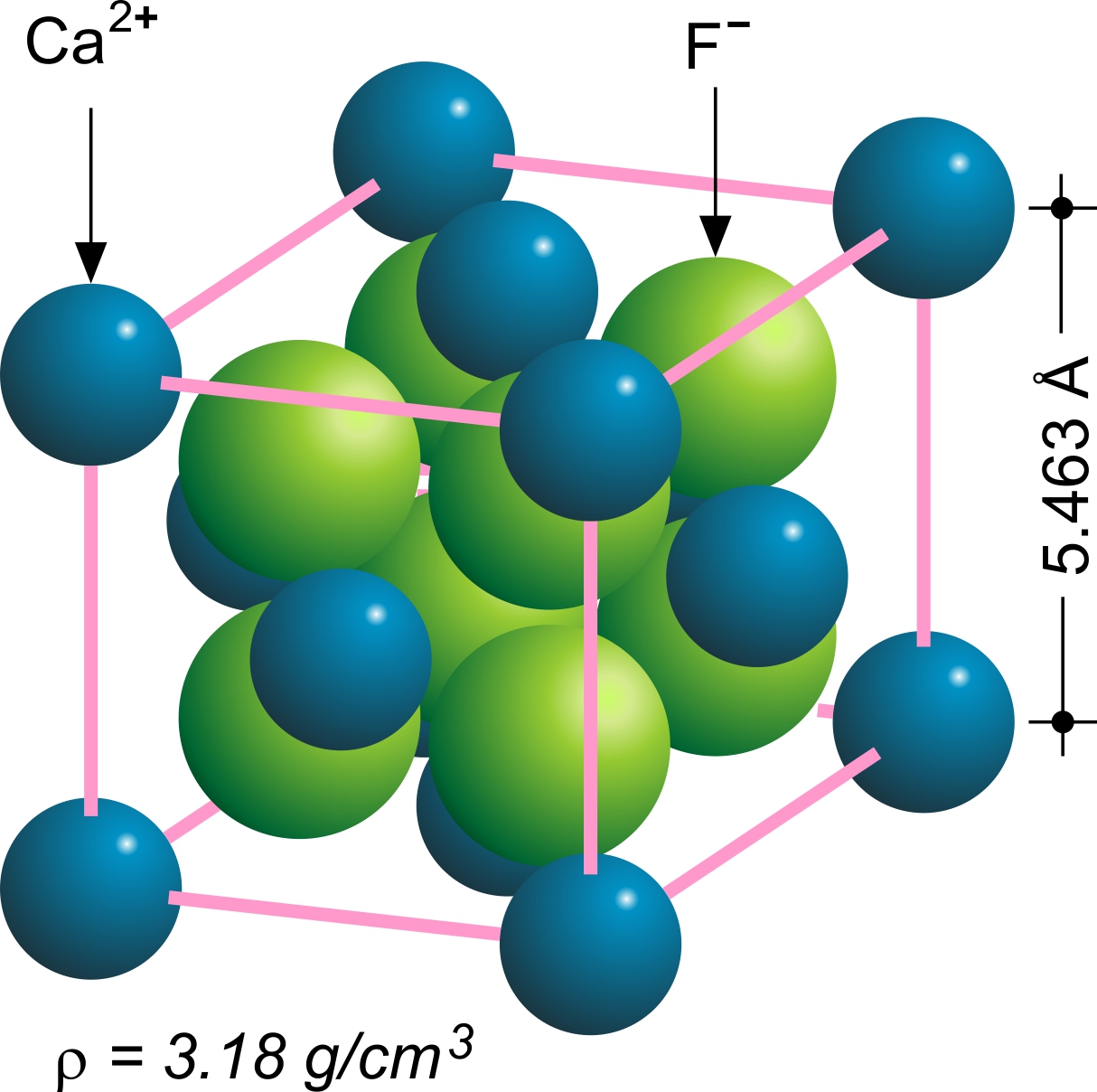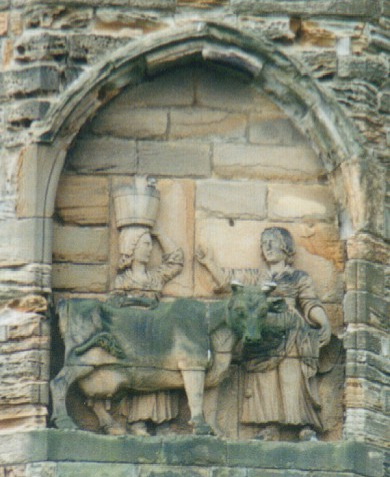|
Frosterley
Frosterley is a village in the civil parish of Stanhope, in County Durham, England. It is situated in Weardale, on the River Wear close to its confluence with Bollihope Burn; between Wolsingham and Stanhope; west of Durham City and southwest of Newcastle upon Tyne. In the 2001 census Frosterley had a population of 705. Frosterley is on the Weardale Railway. Heritage trains currently run to Stanhope, Wolsingham and Witton-le-Wear. History The area has been inhabited since Mesolithic times: Mesolithic flints and Neolithic stones axes have been found in the vicinity. A bronze spearhead was found in a local quarry dating to the late Bronze Age . The village itself has medieval origins, and although the original houses have long been replaced, the village still retains its medieval pattern. On the north of the village are the remains of St Botolph’s Chapel. What remains is an earthwork mound surrounded by a modern housing estate (Kirk Rise). The site was excavated in ... [...More Info...] [...Related Items...] OR: [Wikipedia] [Google] [Baidu] |
Weardale Railway
The Weardale Railway is an independently owned British Single track (rail), single-track branch line heritage railway between and Stanhope. The railway began services in July 2004. The line was purchased by the Auckland Project in 2020 with a view to restarting regular passenger services. In 2021, a bid was submitted to the Restoring Your Railway fund. In October 2021, the Department for Transport allocated funding for the development of a business case. By 2024 progress appeared to have stalled, with the scrapping of the Restoring Your Railway fund. The railway originally ran from Bishop Auckland to Wearhead in County Durham, North-East England, a distance of , built in the 19th century to carry limestone from Eastgate, County Durham, Eastgate-in-Weardale, and provide passenger services to Weardale. Passenger services ceased in 1953, leaving only freight services to Eastgate until 1992. After the quarry's owner Lafarge (company), Lafarge moved to road transport in 1993, the ... [...More Info...] [...Related Items...] OR: [Wikipedia] [Google] [Baidu] |
Stanhope, County Durham
Stanhope is a market town and civil parish in the County Durham district, in the ceremonial county of Durham, England. It lies on the River Wear between Eastgate and Frosterley, in the north-east of Weardale. The main A689 road over the Pennines is crossed by the B6278 between Barnard Castle and Shotley Bridge. In 2001 Stanhope had a population of 1,633, in 2019 an estimate of 1,627, and a figure of 1,602 in the 2011 census for the ONS built-up-area which includes Crawleyside. In 2011 the parish population was 4,581. Governance Stanhope parish is the largest parish area in England, at It has some land in common with the neighbouring Wolsingham civil parish. If Stanhope was a district it would be the 135th largest in England and would be 94th if only counting districts that are 2 tier thus excluding unitary authorities and similar, 2 ceremonial counties namely the City of London and Bristol cover a smaller area. On 31 December 1894 "Stanhope Urban" parish was formed ... [...More Info...] [...Related Items...] OR: [Wikipedia] [Google] [Baidu] |
Weardale
Weardale is a dale, or valley, on the east side of the Pennines in County Durham, England. Large parts of Weardale fall within the North Pennines Area of Outstanding Natural Beauty (AONB) – the second-largest AONB in England and Wales. The upper dale is surrounded by high fells (up to O.D. at Burnhope Seat) and heather grouse moors. The River Wear flows through Weardale before reaching Bishop Auckland and then Durham, meeting the sea at Sunderland. The Wear Valley local government district covered the upper part of the dale, including Weardale, between 1974 and 2009, when it was abolished on County Durham's becoming a unitary authority. (From 1894 to 1974 there was a Weardale Rural District.) Upper Weardale is in the parliamentary constituency of North West Durham. The dale's principal settlements include St John's Chapel and the towns of Crook, Stanhope and Wolsingham. Local climate Weardale's winters are typically harsh and prolonged with regular snow, nowadays ... [...More Info...] [...Related Items...] OR: [Wikipedia] [Google] [Baidu] |
Saint Botolph
Botolph of Thorney (; also called Botolph, Botulph or Botulf; later known as Saint Botolph; died ) was an English abbot and saint. He is regarded as the patron saint of boundaries, and by extension, of trade and travel, as well as various aspects of farming. His feast day is celebrated either on 17 June (England) or 25 June (Scotland). Life and works Little is known about the life of Botolph, other than doubtful details in an account written four hundred years after his death by the 11th-century monk Folcard. Botolph was born sometime in the early 7th century to noble Saxon parents who were Christians. He and his brother Adulph were educated by Saint Fursey at Cnobheresburg monastery. They were then sent to study on the Continent, where they became Benedictines. Adulph remained abroad, where he is said to have become a Bishop. Botolph, returning to England, found favour with a certain "King of the southern Angles", whose sisters he had known in Germany, and was by him perm ... [...More Info...] [...Related Items...] OR: [Wikipedia] [Google] [Baidu] |
Mindat
Mindat may refer to: Places * Mindat District, a district in Chin State, Myanmar (Burma), consisting of two townships and many villages ** Mindat Township, Myanmar *** Mindat, Chin State, a town in Chin State, Myanmar, administrative seat of Mindat Township Other uses * Mindat, alternative name for the Kʼchò language in Myanmar * Mindat Min, a Burmese prince * Mindat.org, an online mineralogy database {{dab, geo ... [...More Info...] [...Related Items...] OR: [Wikipedia] [Google] [Baidu] |
North Pennines
The North Pennines are the northernmost section of the Pennines, a range of hills which run north–south through northern England. They run along the border between County Durham and Northumberland in the east and Cumbria in the west, and are bounded to the north by the Tyne Valley and to the south by the Stainmore Gap. Much of the region is moorland, and it contains significant industrial archaeology. The North Pennines have been designated a national landscape and a UNESCO Global Geopark. Several major rivers rise in the North Pennines, including the Tees and Wear. The part of the area in County Durham, including Teesdale and Weardale, is known as the Durham Dales. Geology The North Pennines are formed from a succession largely of sedimentary rocks laid down during the Palaeozoic era, later intruded by the Whin Sill and affected by glaciation during the Quaternary period. Mud and volcanic ash deposited during the Ordovician and Silurian periods were buried and s ... [...More Info...] [...Related Items...] OR: [Wikipedia] [Google] [Baidu] |
Fluorite
Fluorite (also called fluorspar) is the mineral form of calcium fluoride, CaF2. It belongs to the halide minerals. It crystallizes in isometric cubic habit, although octahedral and more complex isometric forms are not uncommon. The Mohs scale of mineral hardness, based on scratch hardness comparison, defines value 4 as fluorite. Pure fluorite is colourless and transparent, both in visible and ultraviolet light, but impurities usually make it a colorful mineral and the stone has ornamental and lapidary uses. Industrially, fluorite is used as a flux for smelting, and in the production of certain glasses and enamels. The purest grades of fluorite are a source of fluoride for hydrofluoric acid manufacture, which is the intermediate source of most fluorine-containing fine chemicals. Optically clear transparent fluorite has anomalous partial dispersion, that is, its refractive index varies with the wavelength of light in a manner that differs from that of commonly used glasses, ... [...More Info...] [...Related Items...] OR: [Wikipedia] [Google] [Baidu] |
Crinoid
Crinoids are marine invertebrates that make up the class Crinoidea. Crinoids that remain attached to the sea floor by a stalk in their adult form are commonly called sea lilies, while the unstalked forms, called feather stars or comatulids, are members of the largest crinoid order, Comatulida. Crinoids are echinoderms in the phylum Echinodermata, which also includes the starfish, brittle stars, sea urchins and sea cucumbers. They live in both shallow water and in depths of over . Adult crinoids are characterised by having the mouth located on the upper surface. This is surrounded by feeding arms, and is linked to a U-shaped gut, with the anus being located on the oral disc near the mouth. Although the basic echinoderm pattern of fivefold symmetry can be recognised, in most crinoids the five arms are subdivided into ten or more. These have feathery pinnules and are spread wide to gather planktonic particles from the water. At some stage in their lives, most crinoids have a sho ... [...More Info...] [...Related Items...] OR: [Wikipedia] [Google] [Baidu] |
Michael (archangel)
Michael, also called Saint Michael the Archangel, Archangel Michael and Saint Michael the Taxiarch is an archangel and the warrior of God in Christianity, Judaism, and Islam. The earliest surviving mentions of his name are in third- and second-century BC Jewish works, often but not always apocalyptic, where he is the chief of the angels and archangels, and he is the guardian prince of Israel and is responsible for the care of the Israelites, people of Biblical Israel, Israel. Christianity conserved nearly all the Jewish traditions concerning him, and he is mentioned explicitly in Revelation 12:7–12, where he does battle with Satan, and in the Epistle of Jude, where the archangel and the devil dispute over the body of Moses. Old Testament and Apocrypha The Book of Enoch lists him as one of seven archangels (the remaining names are Uriel, Raguel (angel), Raguel, Raphael (archangel), Raphael, Sariel, Gabriel, and Remiel), who, in the Book of Tobit, “stand ready and ente ... [...More Info...] [...Related Items...] OR: [Wikipedia] [Google] [Baidu] |
Durham Cathedral
Durham Cathedral, formally the , is a Church of England cathedral in the city of Durham, England. The cathedral is the seat of the bishop of Durham and is the Mother Church#Cathedral, mother church of the diocese of Durham. It also contains the shrines of the Anglo-Saxons, Anglo-Saxon saints Cuthbert and Bede. There are daily Church of England services at the cathedral, and it received 727,367 visitors in 2019. It is a grade I listed building and forms part of the Durham Castle and Cathedral World Heritage Site. The cathedral is the successor to the Anglo-Saxon Lindisfarne Priory, which was established but abandoned in 875 in the face of Viking Age, Viking raids. The monks settled at Chester-le-Street from 882 until 995, when they moved to Durham. The cathedral remained a monastery until it was Dissolution of the monasteries, dissolved in 1541, since when it has been governed by a Dean of Durham, dean and Chapter (religion), chapter. The cathedral precinct formed part of Durham ... [...More Info...] [...Related Items...] OR: [Wikipedia] [Google] [Baidu] |
Carboniferous Period
The Carboniferous ( ) is a geologic period and system of the Paleozoic era that spans 60 million years, from the end of the Devonian Period Ma (million years ago) to the beginning of the Permian Period, Ma. It is the fifth and penultimate period of the Paleozoic era and the fifth period of the Phanerozoic eon. In North America, the Carboniferous is often treated as two separate geological periods, the earlier Mississippian and the later Pennsylvanian. The name ''Carboniferous'' means "coal-bearing", from the Latin ("coal") and ("bear, carry"), and refers to the many coal beds formed globally during that time. The first of the modern "system" names, it was coined by geologists William Conybeare and William Phillips in 1822, based on a study of the British rock succession. Carboniferous is the period during which both terrestrial animal and land plant life was well established. Stegocephalia (four-limbed vertebrates including true tetrapods), whose forerunners (tetrapodomo ... [...More Info...] [...Related Items...] OR: [Wikipedia] [Google] [Baidu] |
Eilert Ekwall
Bror Oscar Eilert Ekwall (8 January 1877 in Vallsjö – 23 November 1964 in Lund) was a Swedish academic, Professor of English at Sweden's Lund University from 1909 to 1942 and one of the outstanding scholars of the English language in the first half of the 20th century. He wrote works on the history of English, but he is best known as the author of numerous important books on English place-names (in the broadest sense) and personal names. Scholarly works His chief works in this area are ''The Place-Names of Lancashire'' (1922), ''English Place-Names in -ing'' (1923, new edition 1961), ''English River Names'' (1928), ''Studies on English Place- and Personal Names'' (1931), ''Studies on English Place-Names'' (1936), ''Street-Names of the City of London'' (1954), ''Studies on the Population of Medieval London'' (1956), and the monumental ''Concise Oxford Dictionary of English Place-Names'' (1936, new editions 1940, 1947/51 and the last in 1960). The ''Dictionary'' remained the st ... [...More Info...] [...Related Items...] OR: [Wikipedia] [Google] [Baidu] |







